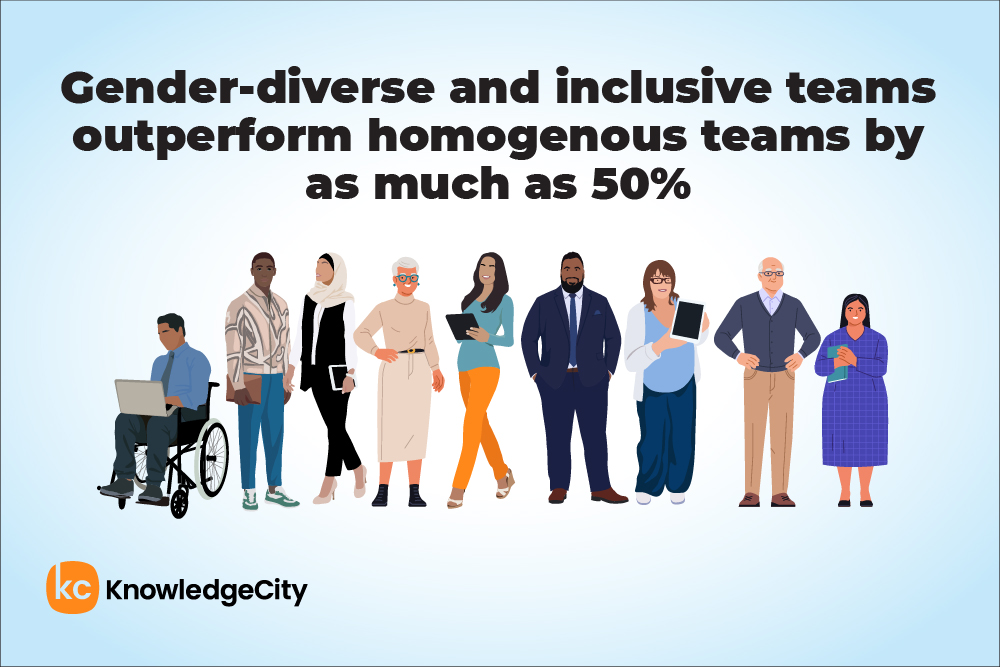Understanding Gender Inclusivity
Current and prospective employees seek a true commitment to authentic diversity and gender inclusion in the workplace. They want to bring their whole selves to work and have the ability to express and live out their gender identity in the way they choose. Companies want to create an environment where everyone is at their most productive and retain employees by providing fair and equal opportunities.

It’s important to make sure everyone in your company has a shared, accurate understanding of what gender identity, diversity, and inclusion all mean.
Global Mindful Solutions describes the difference between biological sex and gender identity like this: “Not to be confused with biological sex, which is assigned at birth, gender identity is one’s own concept of their gender. Whether they identify as female, male, both, neither, or something else, gender and gender identity both exist on a spectrum.”
Netchex defines diversity as “aiming for a mix of people who represent a wide range of groups” and focuses on ethnicities, genders, and other demographic information. Inclusion takes this a step further by being “the pro-active process of making sure that minority groups are empowered and heard.”
Without inclusion, diversity initiatives rarely succeed and often feel hollow. If diversity is about bringing in a diverse set of people, inclusion is about creating a workplace where they’re heard and supported so they’ll want to stay. Gender inclusivity in the workplace is important to today’s employees.
Acceptance is the Key to a Healthy Workplace
At its core, workplace gender inclusion is about making your employees feel safe. They’re more likely to be actively involved in workplace culture if they feel supported. People do better work when they don’t have to hide or mask parts of themselves. Improving gender inclusivity has several positive impacts, both on your company’s culture and on its bottom line.
Allowing your employees to bring their authentic selves to work creates a more diverse set of perspectives. When everyone feels like they can safely share their experiences and opinions, they give feedback more openly and are more invested in helping make changes to improve company culture.
Empowering all levels of your company to ask questions and share their suggestions leads to a more diverse end product that appeals to a wider customer base.
According to the University of North Carolina at Pembroke, gender-diverse and inclusive teams outperform homogenous teams by as much as 50%. The team’s initial formation may take a bit longer because there are more differences in backgrounds and work styles. But once the team settles and identifies the best ways to interact with each other, productivity and innovation take off. That innovation is driven by the varied perspectives that come from diversified teams.
The Global Head of Diversity, Equity, and Inclusion at Simon-Kucher & Partners, Dr. Paulette Gerkovich and Dr. David Rock assert that diverse teams tend to put a greater focus on facts and examine them more carefully. They’re not as likely to fall into groupthink.
The best way to show support for gender inclusion at work is to lead by example. Here are a few simple ways that you can start leading your teams toward a more inclusive workplace.
Use Gender-Inclusive Language
Normalize the usage of correct pronouns and gender-inclusive language. You can model gender-inclusive behavior by adding gender pronouns to business cards and email signatures. You can also encourage others to do the same by openly using their preferred pronouns.
Allow your employees to go by their preferred name if it differs from their legal name and make sure leaders use preferred names and pronouns consistently.
It can be difficult to remember how to address a person if they change their preferences or open up about them for the first time. Making an effort to quickly adopt their new identity shows respect and support. When in doubt, you should default to gender-neutral language and pronouns.
To do this, leaders may need to update their lexicon. The University of North Carolina at Chapel Hill provides a list of gendered-language words and their gender-neutral alternatives. To further your knowledge of inclusive language even more, you can get started with the Inclusive Language Guidelines from the American Psychological Association.
Create a Safe Space
Keep in mind that not everyone agrees on what language is inclusive and respectful. It’s best to ask someone their preferences and then use whatever words make them the most comfortable.
Unless the person has already brought it up, these types of questions should be asked in private. Every individual is different, and it should be up to them if, when, and how they reveal their gender status, pronouns, or other diversity preferences. Consider the matter personal, private, and confidential until they openly share or grant permission for you to share.
Creating a gender-inclusive workplace requires a commitment to continuously seeking feedback and working together to improve and adapt. You can keep this culture going by having an open-door policy or open office hours where employees can drop in and share feedback privately. They can contribute ideas without fear of retaliation or being identified to the broader team.
Regular town hall and small group culture conversations are other ways for you to interact with employees in large and small settings. You can utilize these opportunities to give updates, answer questions, and get feedback on how to improve gender inclusion in the workplace.
Celebrate Differences
Encourage your employees to express themselves and celebrate them when they do. Give gender-diverse employees a platform to highlight their work and find ways to include them in projects that need more diversity. This kind of executive sponsorship of gender inclusion at work demonstrates your commitment to diversity. It also brings new perspectives to projects and helps individuals identify leaders as potential mentors.
Another area where you can allow employees to dedicate time and gain visibility is by visibly celebrating diversity awareness. Include diversity awareness calendar events in the rhythm of business planning. Seek out employee opinions for the best ways to celebrate gender-related celebrations such as:
- Women’s History Month
- International Women’s Day
- Pride Month
- Transgender Awareness Month
- And any other applicable holidays
Remember that different countries and regions may celebrate gender in distinct ways or on alternate dates. Be sure to include feedback from employees who work in another geographic area and plan local events if needed.
What Does it Mean to be Gender-Inclusive?
Beyond leading by example as individuals, company leaders must come together to discuss what needs to be updated for the company to create a more inclusive work environment.
The first step is ensuring that your company’s mission, values, and diversity statements are up-to-date and published in an easy-to-find location, both internally and externally.
Those documents should directly address gender inclusion in the workplace.
Current employees should know the company’s values and commitment to inclusivity and be able to identify examples of them in action. Potential employees, customers, and partners will also be interested in your company’s commitment to an inclusive work environment.
Catalyst.org and Forbes outline updates companies can make to create a gender-inclusive workplace.
Update Company Policies
Operational support systems, such as human resource documentation, may require changes. These are fundamental support systems that employees rely on, so it’s imperative that your company updates forms and the employee handbook to eliminate gender-based language and include diverse pronouns. Ensure all gender identities and associated gender-affirmative care are covered by company-sponsored benefits programs.
Non-discrimination and anti-harassment policies should also be updated to include protections for gender expression, identity, and performance. Incidents should be tracked and addressed with as much transparency as possible.
Seek feedback from current employees about what’s going well and what needs to be improved. Look at the data over time to measure improvements and uncover potential issues. Offer exit interviews to employees that leave your company and track their responses. This may reveal trends and topics that require further scrutiny.
Training is another area where updates or additions of brand-new content may be necessary. It’s important that your company offers well-rounded diversity training to help employees learn to be mindful and respectful of their colleagues and to keep them up to date on changes to company policies.
Teaching everyone how to be inclusive at work helps marginalized groups feel supported. This also gives allies practical ideas for how to be supportive and recognize and address discrimination when it happens.
Update Hiring and Promotion Processes
Recruiting and interviewing practices may need to be reviewed and updated to ensure bias doesn’t interfere with hiring. All interviewers should be trained to recognize and appropriately handle unconscious bias. In addition, hiring processes can be reviewed for opportunities to eliminate unconscious bias. Blind hiring is a great example of this.
Blind hiring is when names and gender identifiers are removed from candidates’ resumes. This helps ensure candidates are evaluated and moved forward for interviews based on their experience. Removing names also helps remove any ethnic bias that might come up due to a person’s name.
Another way to improve hiring practices is to expand and diversify your applicant pool. This may mean additional work for recruiters and hiring managers to build a diversified roster. The search for candidates might take longer, especially if your company is still learning how and where to reach new candidates.
Some companies set minimum diversity requirements for who should be included as candidates so that every hiring manager considers multiple people from a variety of backgrounds.
On the other hand, having a diverse set of interviewers is also important. Candidates are more likely to relate to your company if they see other people like them, or at least a variety of people when they come in to interview. Taking the time to train a gender-diverse set of interviewers and working around their schedules can help your company showcase its commitment to gender inclusion.
Promotion processes should also be given a higher level of scrutiny if your company lacks diversity at its leadership and senior leadership levels. Standardized review and promotion processes and dialogue across a broader spectrum of leaders help ensure that your employees are measured fairly across groups.
Leaders can work together to make sure employees are promoted based on their performance and results, not favoritism or bias.
Update Company Facilities
Updating company facilities might seem like a no-brainer, but it can be expensive and disruptive because it involves making significant changes to buildings where people work daily.
Everyone should be able to use the facilities for the gender with which they identify. If a building doesn’t have single-stall restrooms, a temporary solution might be to convert some existing larger restrooms to gender-neutral restrooms. Company diversity training could be used to establish everyone’s right to use the restroom without being questioned in company diversity training.
If your company has a dress code, it should be reviewed and updated to be gender inclusive. For example, if women are expected to wear skirts, this could be updated to give the option of wearing skirts or slacks.
A single dress code that works for everyone should be introduced. If that’s not feasible, then additional options must be added for employees who don’t identify with binary norms.
Conclusion
Creating a gender-inclusive workplace requires commitment and ongoing investment from leaders to ensure policies are well-defined, equally enforced, and regularly evaluated for feedback and improvements.
The benefits of prioritizing gender inclusion at work make the effort worth it. Employees who feel seen, heard, and able to be themselves are happier and more productive at work. They contribute more ideas and help create products that appeal to a more diverse set of customers.
Subscribe to Our Newsletter
Join 80,000+ Fellow HR Professionals. Get expert recruiting and training tips straight
to your inbox, and become a better HR manager.

 Allison Bokone
Allison Bokone 



